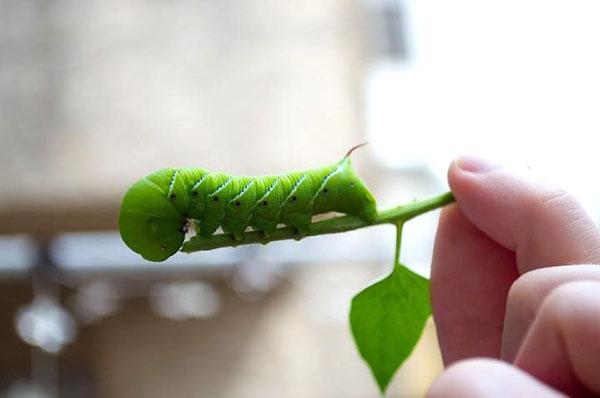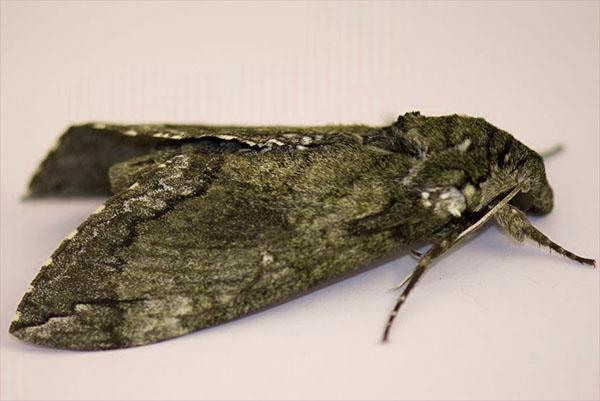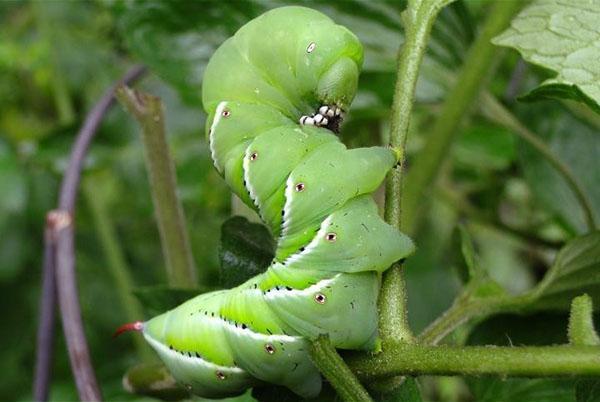Tobacco hawk on tomatoes
 In this article, we will share the experience of foreign gardeners on how to identify, control and counteract tobacco hawk moth, which can become a huge problem for plants, in particular for tomatoes.
In this article, we will share the experience of foreign gardeners on how to identify, control and counteract tobacco hawk moth, which can become a huge problem for plants, in particular for tomatoes.
The life cycle of a tobacco hawk

Hawk moths live according to the following life cycle:
- in late spring, on the underside of the leaves, adult butterflies lay eggs, which hatch after a week;
- The larvae will feed for 4 to 6 weeks before creating a cocoon for wintering in the soil, however, if the weather is warm enough, the caterpillars may burrow for only 2-3 weeks;
- butterflies emerge in the spring and then lay eggs again.
In warm climates, more than one cycle can occur per year
How to identify a tomato caterpillar
 Tomato hawk moths can reach 12 cm in length, so for an unprepared person, meeting this insect can be a real shock. They bring the greatest harm in the form of caterpillars, or larvae. The pests are pale green with black markings and a horn-like protuberance located at the back of the body.
Tomato hawk moths can reach 12 cm in length, so for an unprepared person, meeting this insect can be a real shock. They bring the greatest harm in the form of caterpillars, or larvae. The pests are pale green with black markings and a horn-like protuberance located at the back of the body.
Do not be afraid of this frightening "horn", caterpillars are not able to sting you.
The hawk moth has 8 V-shaped stripes on its back. Tomato caterpillars emerge from the eggs of a large brown butterfly.
The larvae almost completely merge with the vegetation. Just make it a habit to check daily for hawk moth eggs and small caterpillars. Here are some signs that these pests are in your garden:
- Look closely at the top of the tomato leaves. If you find dark green droppings (left by larvae feeding on these leaves), look at the underside of the leaf and you will most likely find tobacco hawk moth.
- Look for stems that are completely devoid or that have withered foliage. On these, you can find white cocoons and their owners nearby.
If you see large holes on the leaves, or numerous bare stems, destroyed flowers and scars on the surface of the fruit, be sure that you have a tobacco hawk in your garden. Fruits can also get sunburn as a result of reduced foliage density.
How to get rid of a tomato caterpillar
 Hand picking is an excellent pest control method, provided you have the time and patience and the garden is small enough. Caterpillars are not dangerous and cannot sting. If you are squeamish and you find it unpleasant to crush these large insects, you can simply throw them into soapy water.
Hand picking is an excellent pest control method, provided you have the time and patience and the garden is small enough. Caterpillars are not dangerous and cannot sting. If you are squeamish and you find it unpleasant to crush these large insects, you can simply throw them into soapy water.
If the hawk moth population is too large or the garden is very large, insecticides will be the best option. You can use bitoxibacillin, which contains the bacteria "Bacillus Thuringiensis". It acts as a stomach poison for caterpillars, but does not harm plants or pets.
How to keep caterpillars from breeding
 Here are some effective ways to deal with the problem early and keep pests out of your garden.
Here are some effective ways to deal with the problem early and keep pests out of your garden.
Loosen and stir the soil at the beginning and end of each season to find larvae hiding for the winter. Experience shows that this kills about 90% of all caterpillars.
Wasps are beneficial insects that feed on tomato caterpillars and provide natural population control. In the photo below, you can see a hawk moth with wasp larvae attached to its back, similar to grains of rice. These caterpillars attacked by wasps pose almost no threat to plants, so leave them alone and let the life cycle take its course.
Sow dill and basil in the aisles to scare away the hawthorn. Marigolds and marigolds are also good planting companions and ward off many pests.
As you can see, pesticides are not always the best insect repellent. Paying proper attention and time to inspecting plants and collecting caterpillars by hand can significantly reduce their population. If at the same time you do not neglect preventive measures at the beginning and end of the season, then the plants in the garden will be healthy and fruitful.